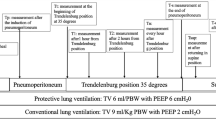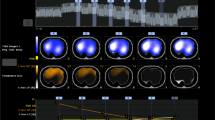Abstract
Background
Because of the creation of a pneumoperitoneum, impairment of ventilation is a common side-effect during laparoscopic surgery. Electrical impedance tomography (EIT) is a method with the potential for becoming a tool to quantify these alterations during surgery. We have studied the change of regional ventilation during and after laparoscopic surgery with EIT and compared the diagnostic findings with computed tomography (CT) scans in a porcine study.
Materials and methods
After approval by the local animal ethics committee, six pigs were included in the study. Two laparoscopic operations were performed [colon resection (n=3) and fundoplicatio (n=3)]. The EIT measurements (6th parasternal intercostal space) were continuously recorded by an EIT prototype (EIT Evaluation Kit, Dräger Medical, Lübeck, Germany). To verify ventilatory alterations detected by EIT, a CT scan was performed postoperatively.
Results
Ventilation with defined tidal volumes was significantly correlated to EIT measurements (r 2=0.99). After creation of the pneumoperitoneum, lung compliance typically decreased, which agreed well with an alteration of the distribution of pulmonary ventilation measured by EIT. Elevation of positive end-inspiratory pressure reopened non-aerated lung areas and showed a recovery of the regional ventilation measured by EIT. Additionally, we could detect pulmonary complications by EIT monitoring as verified by CT scans postoperatively.
Conclusion
EIT monitoring can be used as a continuous non-invasive intraoperative monitor of ventilation to detect regional changes of ventilation and pulmonary complications during laparoscopic surgery. These EIT findings indicate that surgeons and anesthetists may eventually be able to optimize ventilation directly in the operating theatre.





Similar content being viewed by others
References
Sharma KC, Brandstetter RD, Brensilver JM, Jung LD (1996) Cardiopulmonary physiology and pathophysiology as a consequence of laparoscopic surgery. Chest 110:810–815
Nguyen NT, Wolfe BM (2005) The physiologic effects of pneumoperitoneum in the morbidly obese. Ann Surg 241:219–226
Andersson LE, Baath M, Thorne A, Aspelin P, Odeberg-Wernerman S (2005) Effect of carbon dioxide pneumoperitoneum on development of atelectasis during anesthesia, examined by spiral computed tomography. Anesthesiology 102:293–299
Sharma KC, Kabinoff G, Ducheine Y, Tierney J, Brandstetter RD (1997) Laparoscopic surgery and its potential for medical complications. Heart Lung 26:52–64
Gutt CN, Oniu T, Mehrabi A, Schemmer P, Kashfi A, Kraus T, Buchler MW (2004) Circulatory and respiratory complications of carbon dioxide insufflation. Dig Surg 21:95–105
Frerichs I, Hahn G, Golisch W, Kurpitz M, Burchardi H, Hellige G (1998) Monitoring perioperative changes in distribution of pulmonary ventilation by functional electrical impedance tomography. Acta Anaesthesiol Scand 42:721–726
Victorino JA, Borges JB, Okamoto VN, Matos GF, Tucci MR, Caramez MP, Tanaka H, Sipmann FS, Santos DC, Barbas CS, Carvalho CR, Amato MB (2004) Imbalances in regional lung ventilation: a validation study on electrical impedance tomography. Am J Respir Crit Care Med 169:791–800
Brown BH (2003) Electrical impedance tomography (EIT): a review. J Med Eng Technol 27:97–108
Barber DC (1989) A review of image reconstruction techniques for electrical impedance tomography. Med Phys 16:162–169
Frerichs I, Hinz J, Herrmann P, Weisser G, Hahn G, Dudykevych T, Quintel M, Hellige G (2002) Detection of local lung air content by electrical impedance tomography compared with electron beam CT. J Appl Physiol 93:660–666
Blue RS, Isaacson D, Newell JC (2000) Real-time three-dimensional electrical impedance imaging. Physiol Meas 21:15–26
Hahn G, Beer M, Frerichs I, Dudykevych T, Schroder T, Hellige G (2000) A simple method to check the dynamic performance of electrical impedance tomography systems. Physiol Meas 21:53–60
Frerichs I, Hahn G, Hellige G (1999) Thoracic electrical impedance tomographic measurements during volume controlled ventilation-effects of tidal volume and positive end-expiratory pressure. IEEE Trans Med Imag 18:764–773
Adler A, Amyot R, Guardo R, Bates JH, Berthiaume Y (1997) Monitoring changes in lung air and liquid volumes with electrical impedance tomography. J Appl Physiol 83:1762–1767
van Genderingen HR, van Vught AJ, Jansen JR (2003) Estimation of regional lung volume changes by electrical impedance pressures tomography during a pressure-volume maneuver. Intensive Care Med 29:233–240
Hinz J, Neumann P, Dudykevych T, Andersson LG, Wrigge H, Burchardi H, Hedenstierna G (2003) Regional ventilation by electrical impedance tomography: a comparison with ventilation scintigraphy in pigs. Chest 124:314–322
Kunst PW, Vonk Noordegraaf A, Hoekstra OS, Postmus PE, de Vries PM (1998) Ventilation and perfusion imaging by electrical impedance tomography: a comparison with radionuclide scanning. Physiol Meas 19:481–490
Kunst PW, Vazquez de Anda G, Bohm SH, Faes TJ, Lachmann B, Postmus PE, de Vries PM (2000) Monitoring of recruitment and derecruitment by electrical impedance tomography in a model of acute lung injury. Crit Care Med 28:3891–3895
Adler A, Shinozuka N, Berthiaume Y, Guardo R, Bates JH (1998) Electrical impedance tomography can monitor dynamic hyperinflation in dogs. J Appl Physiol 84:726–732
Joris JL, Chiche JD, Lamy ML (1995) Pneumothorax during laparoscopic fundoplication: diagnosis and treatment with positive end-expiratory pressure. Anesth Analg 81:993–1000
Wolf GK, Arnold JH (2005) Noninvasive assessment of lung volume: respiratory inductance plethysmography and electrical impedance tomography. Crit Care Med 33:S163–S169
Hahn G, Hartung C, Hellige C (1998) Elektrische Impedanztomographie (EIT) als Methode zur regionalen Beurteilung der Lungenventilaiton. Fischer, Stuttgart, p 69
Acknowledgements
We thank Eckhard Teschner, Dräger Medical, for technical support and Dr. Ralf Noel, Doctor of Veterinary Medicine, University of Lübeck, for help with the animal preparations.
Author information
Authors and Affiliations
Corresponding author
Rights and permissions
About this article
Cite this article
Meier, T., Leibecke, T., Eckmann, C. et al. Electrical impedance tomography: changes in distribution of pulmonary ventilation during laparoscopic surgery in a porcine model. Langenbecks Arch Surg 391, 383–389 (2006). https://doi.org/10.1007/s00423-006-0034-8
Received:
Accepted:
Published:
Issue Date:
DOI: https://doi.org/10.1007/s00423-006-0034-8




